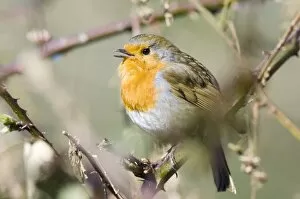European Robin Collection (page 8)
The European robin, also known as the Redbreast or Erithacus rubecula, is a charming bird that brings joy to the winter landscape
All Professionally Made to Order for Quick Shipping
The European robin, also known as the Redbreast or Erithacus rubecula, is a charming bird that brings joy to the winter landscape. In snowy scenes, this small bird stands out with its vibrant red breast and brown feathers on its back and tail. At RSPB Leighton Moss Bird Reserve in Lancashire, England, you can spot these delightful robins hopping around, feeding on berries and seeds. With its bright red breast and blue stripe to the side, the European robin is truly a sight to behold. Its presence adds color to any garden or woodland area. In Germany during January, these robins can be seen feasting on Gelder Rose berries. Illustrations of this beautiful bird showcase its distinctive features - from the striking red breast to the brown feathers adorning its back and tail. The European robin's appearance is truly captivating. Sometimes found alongside other birds like common redstarts, these sociable robins are often spotted perched in sycamore trees or among hoar-frosted vegetation. Their ability to adapt makes them resilient even in harsh conditions. As spring arrives in Bavaria, Germany, you may hear the melodious song of a robin perched on a branch. This enchanting sound fills the air as they welcome warmer days ahead. In November in Germany when rose hips (Rosa) are abundant, it's not uncommon to see a European robin perched gracefully on a branch while enjoying this seasonal treat. The European robin embodies beauty and resilience throughout different seasons. Whether it's their striking appearance against snow-covered landscapes or their cheerful songs filling gardens in springtime – there's no denying that these birds hold a special place in our hearts.










